Note: If an image ever fails to appear - refresh your page, it really is there
Flags Over Early California
Also see: | Flags of Mexico | Flags of Texas Independence | Period Flags of United States |
New feature: | The California Flag Picture Gallery | - some real photos of real flags.

Spanish Royal Standard
|
Cabrillo Expedition Flag 1542
Juan Rodríguez Cabrillo led the first Spanish expedition by sea to explore what is now the coast of California. Cabrillo departed from the port of Navidad, Mexico, in June of 1542. Three months later he arrived at what is known today as San Diego Bay. He then sailed north, missed Monterey Bay, but stopped in San Francisco Bay to look for gold, eventually sailing as far north as the Russian River before autumn storms forced them to turn back. Cabrillo stopped briefly at Santa Catalina Island to make repairs and when stepping out of his boat stumbled on the rocks and splintered his shin. The injury developed gangrene and he died on January 3, 1543. His second-in-command then successfully brought the remainder of the party safely back to Navidad.
Not truly having an official Spanish National flag, most explorers used the Spanish Royal Standard to represent the King and Queen of Spain. |
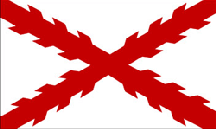
Cross of Burgundy
|
Cross of Burgundy Flag 1506-1843
The Cross of Burgundy Flag, used by Spain between 1506-1701 as a naval ensign, and until 1843 as a land military flag, was the flag of New Spain carried by Gaspar de Portola and Father Junipero Serra on their famous land exploration of California in 1769-1770 which led to the discovery of Monterey Bay and the founding of Mission San Carlos Borromeo de Carmelo and the Presidio of Monterey.
Although Nueva España (New Spain) never actually had a flag of its own, this standard was used to represent army groups, army headquarters, or commanders of such groups (captain-generals, etc.) in the area after Cortez's conquest of Mexico. |
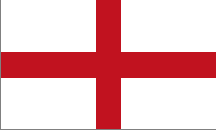
Sir Francis Drake's Flag
|
The Flag of England 1579
This would have been the English flag planted by Sir Francis Drake at Drake's Bay on June 17, 1579. It flew over California, which he called "New Albion," for only 37 days.
Drake was one of Queen Elizabeth's most successful "pirates" that she un-officially supported and encouraged to prey on Spanish shipping. Her goal was to buildup the English navy so that it could rival the Spanish fleet. These English ships attacked Spanish ships bringing back treasure from the New World. Drakes' ship, the Pelican, was renamed the "Golden Hind" for his historic voyage of 1578-1579, where he managed to capture the famed "Manila Gallon" on the Pacific Coast of South America. Pursued by the Spanish Pacific fleet, he fled northward to escape. The Golden Hind stopped briefly in California at Drake's Bay to refit before becoming the second ship to circumnavigate the world on its return to England. |
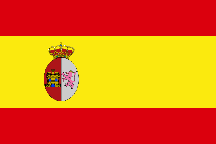
Spanish National Ensign
|
The Spanish National Ensign 1785-1822
The newly created Spanish National Flag replaced the flag raised at San Diego by Gaspar de Portola and Father Junipero Serra. This flag was raised over the Monterey Presidio in 1785 where it continued to fly until the end of Spanish rule in 1822.
This newly created Spanish War and Merchant Flag was chosen by Charles III in 1785 for use in the colonies as a naval and coastal fortifications flag. |
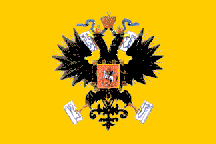
Russian Imperial Standard
|
Personal Standard of the Tsar 1699-1917
There wasn't an official Russian National Flag before 1896, but the Personal Standard of the Tsar, or Imperial Flag, which was a double-headed golden eagle carrying Saint Vladimir's red coat of arms and four scrolls held in beaks and claws on a yellow field, served the purpose.
Russian Navy ships also used an ensign called "The Flag of Russia" to identify their ships (see below). |
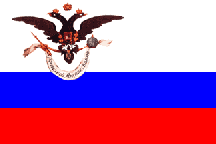
Russian American Company
|
Russian American Company Flag 1799
The Russian-American Company was a trading company chartered by Csar Paul I in 1799. The charter granted the company a monopoly over trade in Russian America. Under the charter, one-third of all profits were to go to the emperor. The Russian-American Company pursued the fur trade in California and in 1812 built a small fort near the Russian River called Ft Ross. Ivan Alexandrovich Kuskov was the builder of Fort Ross and from 1812 to 1821 served as the Russian colonial administrator.
Fort Ross was the southernmost Russian outpost and is now reconstructed at the Fort Ross California State Historical Park. |
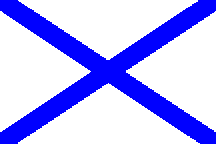
Russian Naval Ensign
|
The Flag of Russia 1812-1841
On September 10, 1812, Ivan Kuskov established Fort Ross and claimed the Northern "Kalifornii" coast for the Czar. He unfurled this flag of Russia, the light blue Cross of St. Andrew on a field of white. This Russian presence near Spanish lands prompted the establishment of a military barracks and Mission in Sonoma. The Sonoma Mission was the furthest north of the 21 California Mission built.
Twenty-nine years later, on December 12, 1841, Captain John A. Sutter bought Fort Ross for $30,000, mostly in foodstuffs and some gold, thus ending the era of Russian presence in Northern California. |
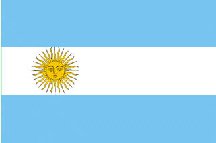
Argentine War Ensign 1818

Flag used by de Bouchard?
|
The War and Naval Ensign of Argentina 1818
In a little known incident, the privateer Hippolyte de Boucharda, commanding two warships of the Argentine Revolutionary Navy occupied Monterey from November 24 to November 29, 1818. Bouchard was French by birth, but an Argentine citizen. The purpose of the attack was to encourage the Alto Californians to rebel against the Spanish government in support of the Mexican War for Independence. Therefore, for a short time, a small portion of the future State of California was under the flag of Argentina (hoisted in support of Mexican independence), although the hoped for spontaneous "Californio" rebellion didn't result at the time.
Although the sun emblem had been added to the War and Naval Ensign of Argentina in February of 1818, it is unlikely that Bouchard knew about it. Most likely he didn't know of the modifications and flew the older bicolour striped flag without the sun on the center stripe. One of his ships, the "La Argentina," became the first Argentine ship to sail around the world flying the new national flag.
After his short stay in Monterey, de Bouchard's small fleet attacked Mission San Juan Capistrano in Southern California, then raided other Spanish ports in Central America. |
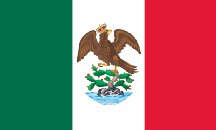
First Mexican National Flag
|
The First Mexican Empire Flag 1821-1823
This flag was used from 1821-1823 during the First Mexican Empire of Agustín de Iturbide. The flag was a green-white-red vertical tricolor with a crowned eagle standing of a nopal raised out from a stone in the middle of the lake.
Most likely, this flag saw little use in California before it was replaced in 1823 by the new First Mexican Federal Republic flag. |
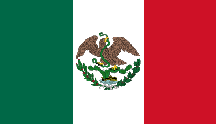
Second Mexican National Flag
|
The First Mexican Federal Republic Flag 1823-1863
This flag was used from 1823-1864 by the first Mexican Federal Republic. This was the second national flag and was adopted in 1823 with the establishment of the first republic. The only difference the new flag had was in the appearance of the central emblem. The crown was removed from the eagle's head and a serpent was placed in the eagle's right talon. Another addition to the flag is a branch of oak and laurel branches, a tradition which is carried over to the current flag. ( To learn more about Mexican flags - Click here ) |
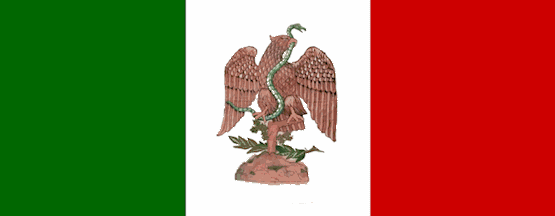
The Monterey Flag
|
The Monterey Mexican Flag 1821-1846
The Monterey Flag shown here is from Pacific House Museum in Monterey, California. It is one of two in their collection, and this particular flag was supposedly used for the Mexican Customs House in Monterey before the arrival of the American fleet in 1846. It was preserved by a local family until donated to the museum.
A conservator's replica of this flag now casually hangs unremarked upon on a wall in the California State Old Customs House Museum's interior display in Monterey above barrows and other display items. The original flag is presently unavailable for public viewing.
|
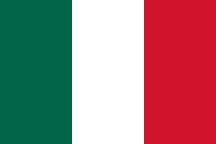
Mexican Civil Flag
|
The Mexican Civil Flag 1821-1864
Whatever the "official" flag flying in 1846, the Mexican troops garrisoning the various presidios in California did not raise the colors every morning, instead they hoisted them only on special occasions, such as the arrival of a ship or a visit by an important official. They all used the plain "civil" flag on a day-to-day basis, which was apparently raised without any special ceremony sometime during the morning and usually taken down, or not, without ceremony sometime in the evening.
The Mexican Civil Flag has also been called the Mexican Merchant Flag briefly between 1864-1865, and later between 1897-1968. |
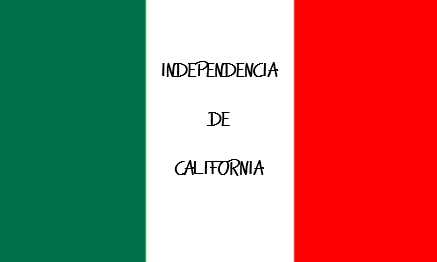
Californio Flag
|
California Mission Independence Flag
This flag is a reconstruction of the flag believed to have been displayed during the first attempt to have California secede from Mexico. It was not uncommon for the Mexican tri-color without the eagle and serpent to have some other device or words substituted. This was a "Californio" attempt. The text on the flag reads INDEPENDENCIA DE CALIFORNIA or "California Independence." The story behind this flag is that Mexican officers sympathetic with the notion of independence for California took this defaced Mexican Civil flag to the Padre at the Mission Santa Barbara. The good father refused it, being against overthrowing the established order, but it was later carried south and flown over the Mission San Buenaventura.
There is no surviving original of this flag. The flag is described in a manuscript held at the Babcroft Library in Berkeley California. |
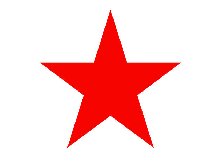
Alvarado's California Flag
|
California "Lone Star" Republic Flag 1836
In 1836, Juan Alvarado vowed to gain increased autonomy for California from Mexican rule with either "bullets or words." He hoisted this white flag with a single, centered, red five-pointed star at Monterey. ( Click here for more on the significance of the red star )
In 1834, Alvarado had been elected to the Alta California Legislature as a delegate and appointed customs inspector in Monterey. The Mexican government had then appointed Lieutenant Colonel Nicolas Guterrez as Governor against the wishes of the legislature. In November of 1836, Alvarado and Jose Castro (with Vallejo's political support) surrounded the presidio at Monterey and forced Guterrez to surrender power to them. At the time of Alvarado's revolt, he still favored remaining a part of Mexico, and working with the Mexican government. With Vallejo's political support, he went on to become a two-time Governor of Alta California from 1836–1837, and later between 1842-1845.
This flag survives and is preserved in the Autry National Center in Pasadena, California. It may be the oldest surviving flag in the State of California. ( Click Here for picture of actual flag in the: California Picture Gallery. ) |
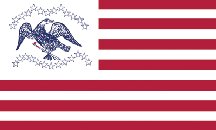
General Frémont Flag
|
The General Frémont "Indian Peace" Flag 1842
This Flag was the regimental banner of western explorer John C. Frémont and was carried on the first of his several trips west between 1841 and 1846. Although, according to his journals, he said he later carried a US flag into California, it isn't clear if it was this particular flag or another he carried.
Frémont was married to Jessie Benton, daughter of Thomas Hart Benton, an influential senator from Missouri. According to most sources Jessie made Frémont's flag by hand. On the plain white canton she drew an eagle which held a Native American "peace pipe" in its claws instead of the traditional wreath and arrows. She also outlined 26 stars in blue in two rows of 13. After his first expedition she sewed grey silk backing onto the flag to which she centered an arch of letters spelling "Rocky Mountains 1841." She did this to commemorate his first expedition. She also placed the image of a butterfly (or bee) flying above the letter "N." ( Click here for picture of actual flag (including inverse) in the: California Picture Gallery. ) The Frémont flag is preserved in the Autry National Center in Pasadena, California.
This flag was later adopted by the City of Fremont, Michigan, as their official city flag when they incorporated in 1875. There are 26 stars on Frémont's flag and Michigan was the 26th State to join the Union, so it seemed a perfect fit. |
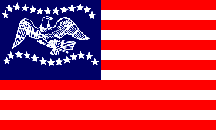
"Suppositious" Flag
(manufacturer's variant)
|
The Fremont Municipal Flag c1960
This variant of the Frémont flag with a reversed canton blue ground with white devices has been widely copied and sold as historical by unsuspecting or uninformed flag companies. Originating as a manufacturer's variant in the 1960s, it unfortunately gained wide acceptance as the "General Frémont Flag," until photos of the actual flag became widely circulated; and corrected historical versions became more readily available.
During the bi-centennial era this flag was used by the City of Fremont, California, as a namesake commemorative municipal flag; and although unofficial, it was supplied to them by several California flag makers. The widespread acceptance of this flag as General Frémont's flag gives us a classic example of a "suppositious" flag (an error repeated so often it becomes accepted as fact), a phrase coined by noted flag historian James Ferrigan. |
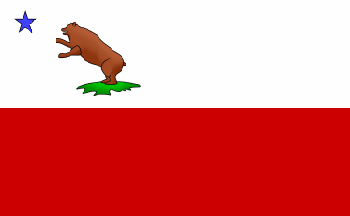
Bear Flag Party Flag
|
The Storm Bear Party Flag c1846-1848
Tradition tells us this flag was sewn by Peter Storm on the evening of June 13, 1846. The story says that he was skilled with a needle, and crafted this flag for the Bear Flag Party (or American Party) the night before he joined it as they moved up the Napa Valley on their way to Sonoma. According to his wife's contemporary account, he used four diapers cloths she had just cut, two red and two white, to make the two stripes on the flag before he sewed his bear emblem on to the white portion. Later, Vallejo's brother would say he thought the emblem on the flag was a pig, not a bear. Anyway, if accurate, this flag would have been carried by the "Bear Flaggers" as they descended on Sonoma on the morning of June 14, 1846, and would predate the Todd flag by a week or so. It may have even been the model that influenced the design of the more well-known Todd Flag.
Until his death in the 1870's Peter Storm, who also helped Todd with his flag, was locally accepted as having made the first Bear Flag. A period photos exist of Storm holding a replica of his flag during a celebration in Napa in 1873, but sadly, since he chose to be buried with his flag in Calistoga, it is lost to history. |
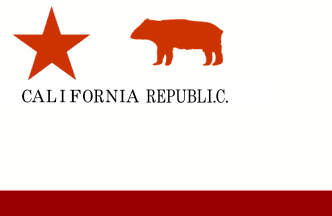
The Todd Bear Flag

The extra period mistake
|
The Bear Flag Republic 1846
It was in 1846 in town of Sonoma that William B. Ide was named the "Commander" of the Bear Flag Revolt. Which Sonoma flag was the first flag of the short-lived California Republic is unclear, but we do know is that this was officially the "last" flag of the California Republic. It was created by William Todd, a nephew of Mary Todd, the wife of Abraham Lincoln. We should note that Todd never claimed his was the first Bear Flag, or the only one.
In a letter to Archibald Gillespie, later printed in the Los Angeles Express, Todd stated that the star and bear on his flag were painted using red paint and "vineberry" juice mixed with brick dust, which made for a faded-reddish tone. The wording was drawn in black India ink, including a period erroneously placed between the "I" and "C." (see enlargement) This mistake allowed him to positively identify the flag years later for the Pioneer's Society. According to the Todd letter the bear was used as a symbol of strength and unyielding resistance. The red strip at the bottom of the flag was made of red flannel; the same cloth then used to make men's "Long John" red flannel underwear. It has been claimed that the use of the red colored star was to recognize the earlier California Lone Star Republic Flag, but this is unsubstantiated.
After being replaced with an American flag in Sonoma, the Todd Flag was taken back to the Washington Naval Yard for a time, but was returned to San Francisco in 1855 where it was given to the Society of California Pioneers. This original Todd Flag was then lost in the fires that followed the great San Francisco earthquake, but not before an 1896 copy of the flag was made that still exists and is on display at the Sonoma State Historical Park Barracks Museum. (Click Here to learn more about the Bear Flag) |
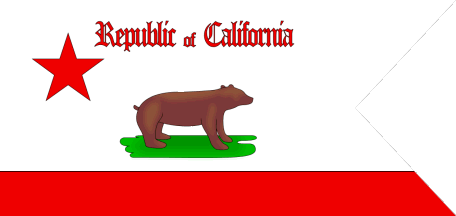
The Revere Guidon
|
The Grigsby Company Bear Guidon
This is the guidon of the Grigsby Company, first named Company B, of the short lived California Republic. John Grigsby's Company was originally one of four organized in the first hectic days of the California revolt in Sonoma. It is often confused with a later federalized company, also commanded by Captain Grigsby, that Commodore Robert Stockton formed into Company E, 1st California Volunteer Militia and U.S. Mounted Rifles, in Monterey later that year.
Made of silk, and small enough to be carried by mounted troops, this guidon is thought to have remained with Captain John Grigsby and his company when they were left to defend Sonoma as the rest of the California Battalion went south under the command of John C. Frémont. Frémont would be promoted to major by Commodore Stockton, and given command of all Volunteer Militia in California in Monterey.
Confusion exists, but somehow the guidon was left behind in Sonoma when Grigsby and his men left. Reportedly the guidon was then removed from the Sonoma barracks by US Naval Lieutenant Joseph Warren Revere, Paul Revere's grandson, as a souvenir. Revere then took the guidon home to Morristown, New Jersey. Later, during the Civil War, Joseph Revere, now a General, according to one account showed the guidon to General William T. Sherman. Sherman suggested that it be returned to California. After the Civil War it was sent by Revere to the California Pioneer's Society in San Francisco, with a letter explaining how it came into his hands. It was, unfortunately, then destroyed, along with the Todd Flag, in the San Francisco Earthquake and Fire of 1906. |

The Pío Pico Bear Flag
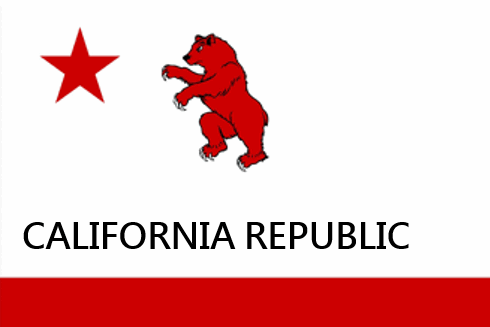
The William Ide Bear Flag
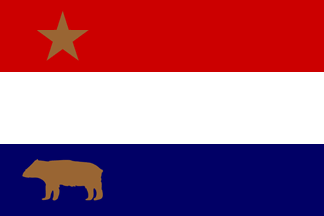
The Swasey Bear Flag

The Semple Bear Flag
|
Other California Bear Flags
There are several additional Bear Flags that were reportedly made in Sonoma and elsewhere during this period, and while none are known to have survived, we are indebted to Hubert Howe Bancroft for his pioneering "History of California," published in 1886, where he preserved written descriptions for posterity. They were first brought to light by vexillologist Harry Knill of Santa Barbara. These speculative illustrations shown here, drawn by Clay Moss, are based on a series of replica flags made by the now defunct Paramount Flag Company of San Francisco and the research of vexillologist James Ferrigan III.
The Pío Pico Bear Flag
Pío Pico was the last Mexican Governor of Alta California. This Bear Flag design, which only appeared as a poorly done sketch at the bottom of a Spanish version of California's Proclamation of Independence sent to Pío Pico, was probably never made into a cloth flag. Most likely the drawing on the document was an attempt inform Pío Pico of what the flag looked like based on hearsay, but this is not known for sure. It should also be noted that this is the only version of the Bear Flag depicting a vertical stripe.
The William Ide Bear Flag
William Brown Ide was the Commander of the short-lived California Republic. This flag was reportedly designed by Captain Henry Ford of Company B of the California Battalion for him. Its design is reminiscent of both the Todd and Storm flags. It is also only based upon a written description.
The William Swasey Bear Flag
Captain William Swasey was a member of the California Battalion, he participated in and observed many of the key events of the Mexican-American War in California, and later wrote of them in his Early Days and Men of California, published in 1896. The red, white, and blue stripes were probably inspired by the American flag.
The Robert Semple Bear Flag
Dr. Robert Baylor Semple founded the town of Benicia in 1847. The Semple flag is based upon a written description, since the original flag has not survived. Dr. Semple was one of the group of men who arrested, paroled, and re-arrested General Vallejo during the hectic days of the establishment of the short lived "Bear Flag Republic." Dr. Semple is also credited with having prevented the expedition from looting Sonoma, stating that they had come there for a "more noble purpose." |

Sutter's Fort Flag
|
Sutter's Fort Flag of 1846
The single red star makes a reappearance at Sutter's Fort. Like its predecessors, the Alvarado Flag of 1836 and the Sonoma Bear Flag, a five-pointed red star was used to indicate the "American" leaning of those leading the rebellion.
Sutter's Fort was the center and headquarters of his vast California ranch named "Nueva Helvecia" (New Switzerland) after his homeland. As an official of the Mexican government Sutter had displayed the Mexican Civil Flag, one without the eagle and serpent. One of these flags was defaced with a red star after news and the prisoners from then Bear Flag Revolt reached Sutter’s Fort. This is most likely the flag that flew at Sutter's Fort during California's brief period of independence. It flew for less than a month, and while Sutter may have tolerated it, he did not design it, or make it. |

The 27-Star Flag Naval Flag
Where would you place the extra star?
|
The Modified Fort Sutter 27-Star Flag 1846
In July of 1846 the US Navy officially took possession of California for the United States. From his northern California anchorage at Yerba Buena (San Francisco), Commodore Sloat dispatched naval landing parties to hoist the United States flag at strategic locations. After flag risings in Yerba Buena, Monterey, Sonoma and other locations, the small fleet had reportedly run out of the then current 28 star ensigns. The party dispatched to Sutter's Fort was given an obsolete 27 star US flag and some star-cloth to be used to convert it while on their way up the American River.
The ultimate appearance of this flag is unknown, but at this time having stars all point "up" was a non-existant style, and during the 1840s it was more common to make all of the rows of stars on US Navy ensigns the same length regardless of the number of stars in each row, so adding an extra star to such a flag "MAY" have looked like this illustration.
|

The McChristian Flag
|
The McChristian Bear Flag 1850
This carefully made flag, now in a private collection, is the only surviving flag known to have belonged to a "Bear Flagger." The meticulous design combines elements of both the Bear Flag and the Stars and Stripes. The style of the bear, because of its remarkable similarity to a famous painting of a California grizzly done by Charles Nahl in 1850, probably indicates the flag was made after this date. Nevertheless, it is one of the oldest surviving Bear Flags and the only known flag with an association to a member of the Bear Flag party.
James McChristian was the last Bear Flagger to die, on June 22, 1914, at 87 years of age in Sebastopol and is buried in the Sebastopol Cemetery. It was discovered among Patrick McChristian´s effects in the early 20th century (father and son). Currently, the McChristian Flag is rumored to be on display at a local winery, according to noted flag scholar James Ferrigan. |
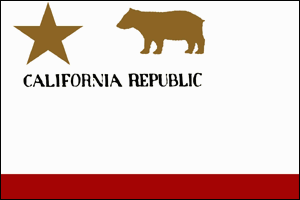
Semi-Centennial Flag
|
The Semi-Centennial Bear Flag 1896
For many years, members of the California Society of Pioneers would carry the original Bear Flag during Admission Day parades and also on anniversaries of the Bear Flag Revolt. A duplicate of the Bear Flag was made in 1896, the 50th Anniversary of the Bear Flag Revolt, and this duplicate flag continues to be displayed at the Sonoma Barracks, in Sonoma, California. Because of the fading of the redish-orange star and bear on the original Todd flag, the Semi-Centennial replica mistakenly showed the star and bear colored in a gold color.
Unfortunately, all of the original Bear flags held by the Pioneer Society were destroyed in April 1906 as a result of the Great San Francisco Earthquake and fires which destroyed the Society's Pioneer Hall, but this copy survives.
|
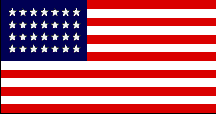
28-Star Flag Over California
|
Commodore Sloat and General Kearney Flag 1846
US Naval Commodore John Drake Sloat was instructed to land in Alta California and claim it for the United States if war broke out between Mexico and the United States. Receiving a report of fighting on the Texas border while off Mazatlán, he raced north, engaged in a skirmish called the Battle of Monterey, then hesitantly raised this flag over the Customs House at Monterey on July 7, 1846, not quite sure war had actually been declared. Strangely enough, it was because Commodore Sloats' predeceaser Commodore Thomas Catesby Jones had mistakenly raised the American flag over Monterey in 1842, then discovered war had not been declared, and had to return Monterey to the Mexicans, that Sloat hesitated. However, once his flag was raised over Monterey, Sloat issued a proclamation announcing that California was now part of the United States. In 1846, Commodore Sloat would served as the first American Military Governor of California.
The 28-Star flag was also probably carried by the American military forces of General Steven Watts Kearney on his land invasion of California from Santa Fe in the same year. General Kearney would become the second military governor of California in 1847.
|
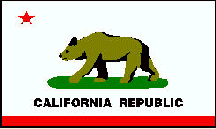
California State (pre-1955)
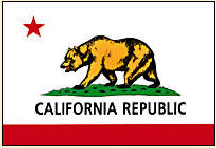
California State (pre-1955)
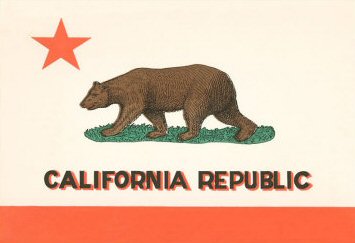
California State (pre-1955)
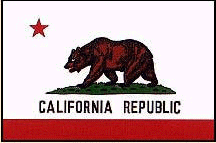
California State (pre-1955)
|
The California State Flag 1911-present
Between 1846 and 1849 California was run by American Military Governors. They were: John Drake Sloat (1846), Robert Field Stockton (1846-1847), John C. Frémont (1847), Stephen W. Kearny (1847), Richard Barnes Mason (acting 1847-1849), Persifor Frazer Smith (1849) and finally Bennett C. Riley both in 1849-1850.
In 1848, gold was discovered and the California Gold Rush practically populated the territory over night. The Compromise of 1850 allowed California to be admitted to the Union as a "Free" state in 1851, but California did not adopt an official State flag for the next 61 years. This was not unusual because most states didn't have or display state flags at this time.
However, the Bear Flag was informally used by the California Society of Pioneers (founded 1850) and both the Native Sons and Daughters of the Golden West (founded 1875) in June celebrations of the Bear Flag Revolt and in September during Admissions Day parades and events. These organizations became very popular at the end of the 19th Century and the first decades of the 20th Century and their usage of the Bear Flag was extremely common. It was, in fact, the Native Sons who successfully promoted the adoption of the Bear Flag as the State Flag to the California Legislature. On February 2, 1911, California Governor Hiram Johnson signed the bill making the Bear Flag the official State Flag.
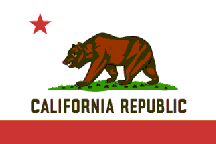
Official California State Flag
(standardized version after 1955) |
Unfortunately, between 1911 and 1955 there were many variations of the California Bear image placed on the flag by manufacturers. In 1911, there was only a written description of the flag, no image, so as long as your design substantially complied with the legal description, you had a state flag. It 1955, however, the bear image was finally standardized using a watercolor done by Charles Nahl in 1850.
|
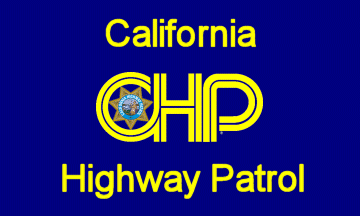
CHP Flag
|
California Highway Patrol 1995
The California Highway Patrol, or CHP, has patrol jurisdiction over all California highways and also acts as the state police. Originally formed as a branch of the California Division of Motor Vehicles in 1929, the CHP was made its own department in 1947. In 1995, it merged with the smaller California State Police. The CHP is also responsible for providing security to state facilities, such as the California State Capitol, and guarding state officials. It is the largest state law enforcement agency in the United States, employing more than 11,000 people.
The flag of the California Highway Patrol is blue with the agency's stylized "CHP" logo in yellow in the center of the field. Above the logo is the word "California" and below are the words "Highway Patrol,"
all in yellow. |
- My thanks to Bill Trinkle, Gustavo Tracchia, and James Ferrigan for their valuable input on this page -
| Top of Page | Flags of Mexico | Flags of Texas | Period Flags of United States |
New feature: | The California Flag Picture Gallery | - some real photos of real flags.
|